What is the sound of an electric vehicle (EV) and how does it compare with that made by a car that has an internal combustion engine?
And how does the sound affect the way people drive an EV?
Anticipating widespread adoption of EVs, four enterprises-DENTSU SOKEN INC. and ESTECH,1 together with Dentsu Lab Tokyo and STARRYWORKS2-have launched a joint project to design the sound for EVs.
Notes:
| 1. | ESTECH and DENTSU SOKEN INC. together establish and operate a driving simulator facility, the Virtual Driving eXperience Studio (VDX Studio). |
|---|---|
| 2. | This company and Dentsu Lab Tokyo provide the sound design solution UNMUTE. |
We spoke to the four core members of the project at VDX Studio in Kanazawa Ward, Yokohama. With Daisuke Tomoyasu (DENTSU SOKEN Inc.), Nobuyuki Himeno (ESTECH), Yasuhiro Tsuchiya (Dentsu Lab Tokyo), and Koji Kimura (STARRYWORKS) talked about their current activities and plans for EV-related sound.
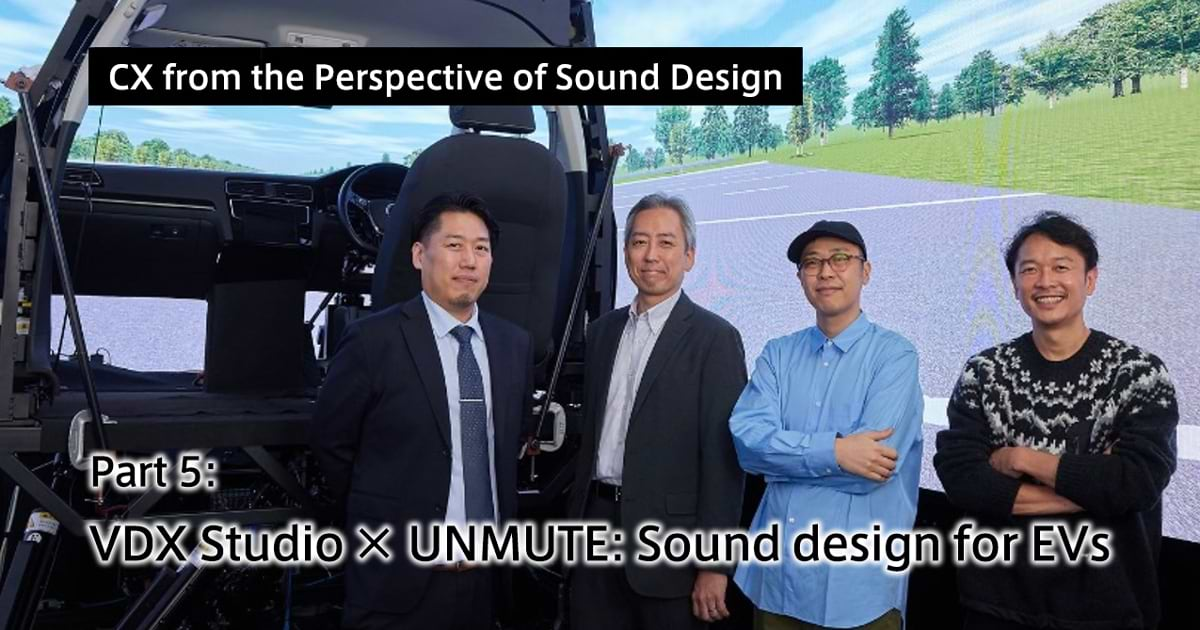
(The roundtable discussion took place last November 16)
Next challenge after noise reduction
—To begin with, what kind of awareness of issues or backgrounds motivated all of you here to start this collaborative projects tacking EV sounds design?
Himeno: How to make cars quieter is a long-standing issue in automobile development. EVs, having motors, don’t make any engine noise. But this has only presented new sound-related challenges. One issue is how to eliminate other sounds that have become irritating due to the absence of engine noise. Another is whether artificial engine noise should be added to enhance aural and driving comfort.
However, there are limitations in using actual vehicles when verifying sound designs. For example, in case of evaluating how sounds will be like if you add other artificial sounds while controlling levels of road and wind noise, it quite difficult to perform a simulation using a real vehicle.
Tomoyasu: Sounds have been evaluated using computer simulations for some time. However, it is not enough to evaluate sounds based solely on what reaches the ears. Automotive sounds, in particular, must be evaluated taking into account complex stimuli, including physical sensations transmitted through vibrations and a visual sense of speed.
This is one of the issue that a highly realistic virtual environment like VDX Studio demonstrate its value. But, not just any driving simulator can do this, a high level of reproducibility is required.The VDX Studio is designed with a focus on immersive displays, vibration devices, and sound reproduction. It aims to create a verification environment that is as close as possible to the actual environment of a vehicle.
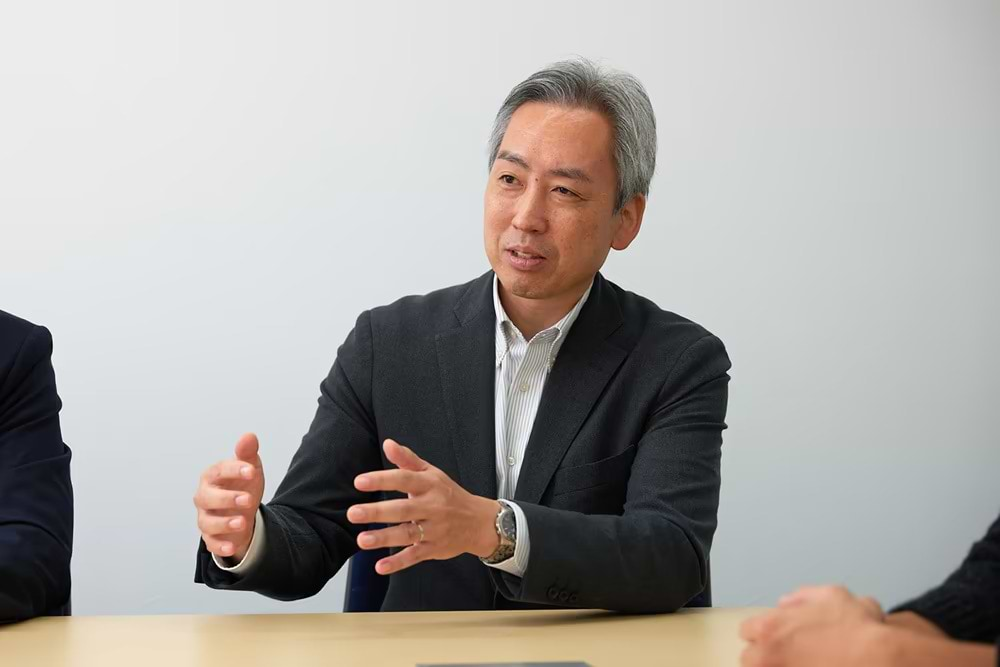
DENTSU SOKEN INC.
Since joining the company, Tomoyasu has supported product development in the manufacturing industry as an engineer who evaluates the movement of objects using multibody dynamics.
He is also involved in the development of an assessment environment for the movement of people, and is taking part in joint research on driving simulators together with automakers. Currently, he is promoting the development of solutions using small driving simulators as a unique verification technology that combines realism and virtuality.
Tsuchiya: When DENTSU SOKEN and ESTECH were developing VDX Studio, an article about a conversation between myself and the artist Yuri Suzuki was published in the online site Dentsu-ho. In that article we discussed exactly how we should approach the sound design of an EV. Tomoyasu read that article and reached out to me to ask if he could be involved.
It just happened that, when he contacted me, Dentsu Lab Tokyo and STARRYWORKS were launching UNMUTE, a specialized sound design solution.
So, first of all, with Kimura I visited the VDX Studio, where I attended a demo. He explained the system to me, sharing detailed data. We then discussed what kind of system we could create on our side that would work in conjunction with the VDX Studio simulator to generate driving sounds in real time.
Kimura: At STARRYWORKS, we obtained vehicle simulation data from VDX Studio and developed a program to link it to the program that generated the sound designed by Tsuchiya. I connected what we developed to VDX Studio and found that it worked quite well.
During development, we generated sounds at our desks, but hearing the sound while actually operating a car in VDX Studio was a fresher, newer experience than I had anticipated. I feel there is great potential in using a place like VDX Studio to conduct experiments related to EV sound design in general, not just driving sounds.
—Since you all come together from different companies, how do you view your respective areas of expertise and roles in the project?
Tsuchiya: I’m in charge of coming up with ideas for the foundation of aural experience design. At this stage, I am also in charge of the specific sound design portion, covering questions such as why we should generate engine sounds, and the kind of driver and vehicle-related data we will use. Kimura is in charge of the systems portion of the project, namely, how we generate the sounds.
Kimura: As Tsuchiya just mentioned, I’m basically in charge of creating interaction mechanisms and UI design, which are STARRYWORKS’s strong areas, and we also come up with ideas together.
Himeno: At ESTECH, I have been providing technical support to customers in areas such as sound, vibration, and vehicle dynamics. Many of our customers are involved in sound development at automakers. Of all the members of this project, I am the one closest to the customers, so my role is to consult with customers about sound from the noise reduction and sound design perspectives.
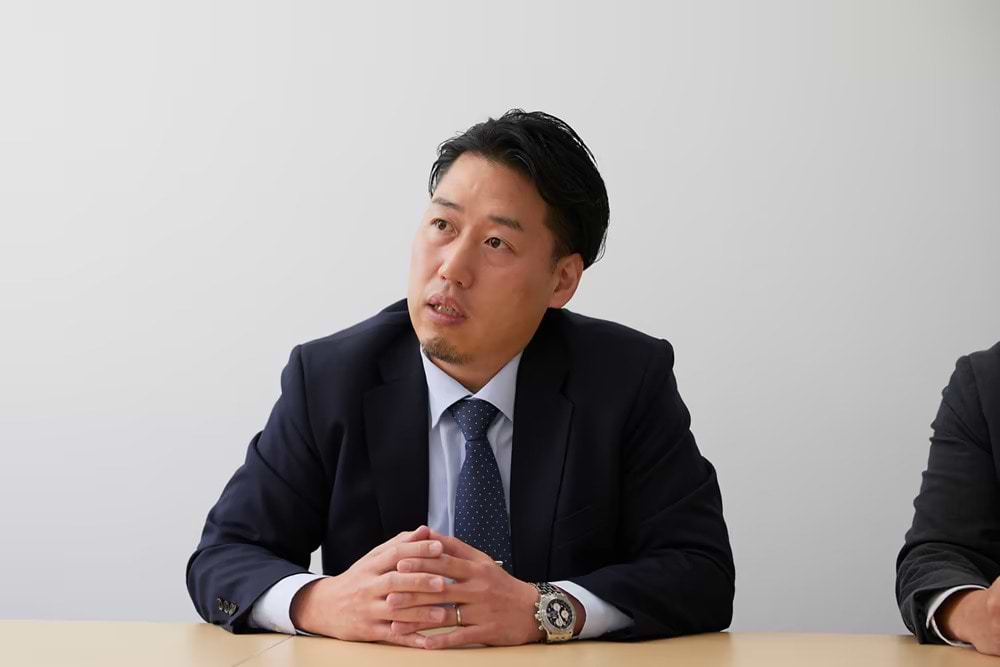
In his previous job, Himeno worked as an engineer at an automobile manufacturer, where he was involved in the development of performance in areas such as vibration noise, handling stability, and ride comfort. Since joining ESTECH, he has poured his energy into technical consulting for various mechanical products, with a focus on automobiles. Currently, he is developing and providing solutions to design dynamic performance that incorporates human sensibilities, utilizing driving simulators.
Tomoyasu: At DENTSU SOKEN, we believe it is important to fully reflect the strengths of our group company, ESTECH, in one of our solutions, and to provide it to our customers.
Even with driving simulators, our knowledge alone is not enough to meet the diverse needs of our customers. So, by combining ESTECH’s actual vehicle diagnostic technology with our technology for building CAE models, we can obtain a substantial boost in realism.
We also has many sales team members who work in a number of industries, including the automotive industry. So I see our role in this project as accurately grasping customers’ issues while planning, developing, and delivering solutions.
Further, with Dentsu Lab Tokyo and STARRYWORKS also involved, I believe we are able to offer more creative sounds in addition to those resulting from our traditional engineering perspectives.
Will sound design change driver behavior?
—Could you run through the overview and features of VDX Studio again?
Tomoyasu: There are many different types of driving simulators, from large ones to small ones. The VDX Studio’s driving simulator falls into the small category. That said, our simulator focuses on reproducing the three main elements that a driver perceives while in the driver’s seat: sounds, vibrations, and visuals. It is fair to say that we offer an exceptionally high level of accuracy on all three counts.
We also rent out the VDX Studio driving simulator to our customers. A major difference between our current simulator and previous simulators is that we operate it not just for own benefit, but as a facility for solving our customers’ problems.
Himeno: For better acoustics, the walls of the VDX Studio are covered with glass wool. It absorbs sound and, while it is not completely echo-free, it creates a simple anechoic state.
In addition, for better sound reproduction, we have incorporated a surround sound system that we developed in-house. By measuring the acoustic transmission characteristics from a total of 16 channels (15 speakers and 1 woofer) to the ear position and using this system to correct the sound, we can reproduce highly realistic sounds where the driver’s ear would be.
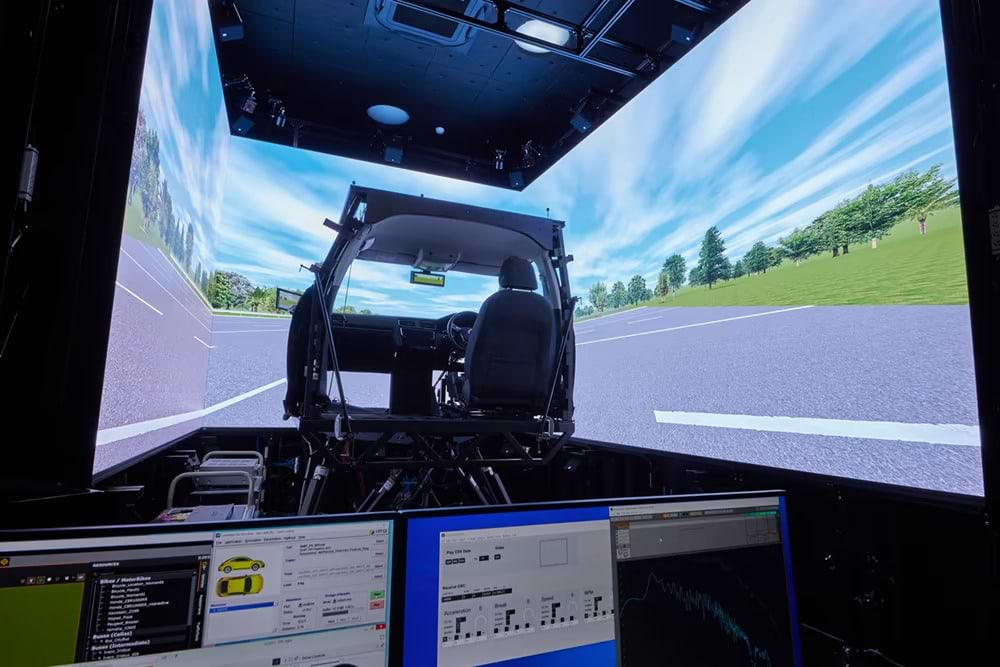
When the driver using the driving simulator (center rear) steps on the accelerator, the data is relayed to a computer (foreground), and a program generates driving sounds. Using a total of 16 channels (15 speakers and one woofer), realistic sounds are reproduced where the driver’s ear would be.
—Prior to this roundtable discussion, we were shown a demonstration of the driving simulator. Could you describe again what is it used to verify?
Tsuchiya: What we demonstrated earlier were driving sounds that we designed experimentally early on, when this project began. The driving sounds were created to represent sounds heard inside the car by the driver. The program obtains such numerical values from the simulator as the amount of pressure applied to the accelerator and the resulting change in motor RPM, and generates sounds reflecting those values.
In the demonstration that you watched earlier, we performed simulations covering a wide range of sounds, from standard driving sounds to four conceptually different kinds of driving sounds.
EV Sounds
These simulate those of an EV in operation. They are very quiet since an EV uses a motor, not an engine.
Driving Sound 1
While simulating the mechanism of engine noise based on throttle opening and RPM, this sound creates a combination of overtones that are structurally impossible for an engine to produce.
Driving Sound 2
The sound is designed to produce resonance. As the RPM increase, the motor has a resonance similar to a string ensemble.
Driving Sound 3
Here we have a sound that simulates a powerful engine of the kind that might be in a racing car.
Driving Sound 4
When the accelerator is depressed, music plays that reflects the speed.
Tsuchiya: What I found interesting is that when I took the design I had prepared and played it in the VDX Studio simulation environment. As the accelerator and brakes were used and the car’s handling changed, there was a slight change in the sound. It seemed to meld the actions of the driver and the car’s response. The subtle changes in sound that occur following even the slightest input by the driver give one a feeling of control over the car.
This is similar to what one feels when driving a car with a combustion engine. Were one to step on the accelerator of such a car, one would feel the higher engine revs with one’s entire body. Perhaps the sound of a car’s engine originally served to reinforce the sense of unity between driver and automobile.
From testing multiple driving sounds at this stage, we learned that, when there were dramatic changes in the sounds—such as music when the driver stepped on the accelerator—the driver’s reaction would be to go faster compared with when they heard other driving sounds. Drivers would start to really lean on the accelerator, or slam on the brakes and enjoy hearing the resulting changes.
This implies that it may be possible to influence driver behavior through engine sound design. For example, if sounds were designed to become muddied when a driver engaged in certain dangerous driving behavior, or the driving noise became louder when a vehicle exceeded the speed limit, it may be possible to design a UX that encourages drivers to follow the rules.
Right now, we have the right environment in place and are making various discoveries through experimentation. But, in future, we hope to continue experimenting, and to create original sounds to meet customer needs.
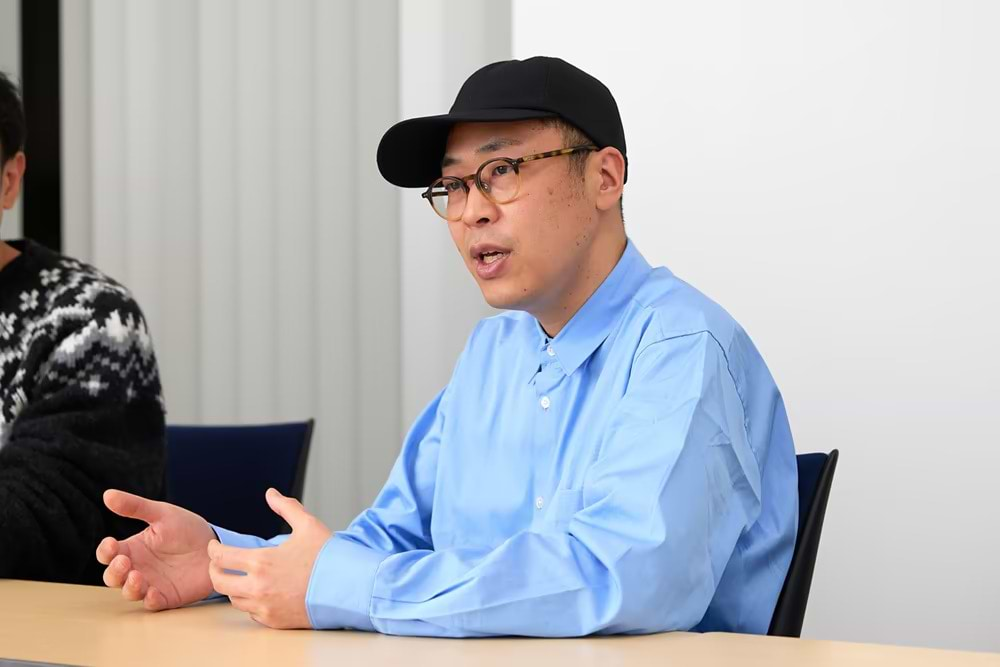
After working in advertising production, Tsuchiya joined Dentsu in 2006. He has been with the CX Creative Center since 2021. With the aim of developing and implementing technology-driven near-future communication, he is engaged in product R&D, mainly in the fields of biosignals and robotics.
Like the face of a smartwatch
—Lastly, please tell us about the prospects for the project.
Tomoyasu: First of all, people in Japan who are toying with vehicle concepts will use the VDX Studio. When trying to create something that has never been done before, I think it is quite a lofty challenge to actually build a prototype and conduct tests. VDX Studio has a high level of reproducibility, so I think it is useful as a place to test proof of concept and accumulate simulation data.
Kimura: This is just my personal opinion but, for example, compared with a mechanical watch, which is a fully-formed piece of hardware, a smartwatch allows one to customize a range of functions oneself, from the band to the face design. An expensive sports car is like an ultra-luxury mechanical watch; it’s a luxury item that goes all out in terms of the hardware and its design, providing joy in ownership and use.
That said, though, as the use of EVs becomes more widespread, and autonomous driving evolves, I see people’s attachment to cars and their attitudes to traveling by car changing. Just as some people choose to set the face of their smartwatch to display a pop culture character, while others choose different illustrations, it may become possible to customize the sounds that play in the car.
Thus, for example, when dad is driving alone he can choose a dynamic driving sound that lets him feel the joy of acceleration. And when mom is driving, she can choose a sound that she finds inspiring. Meanwhile, when the family is driving together, they can choose relatively quiet driving sounds and UI sounds that don’t interfere with conversations, so that family members can converse.
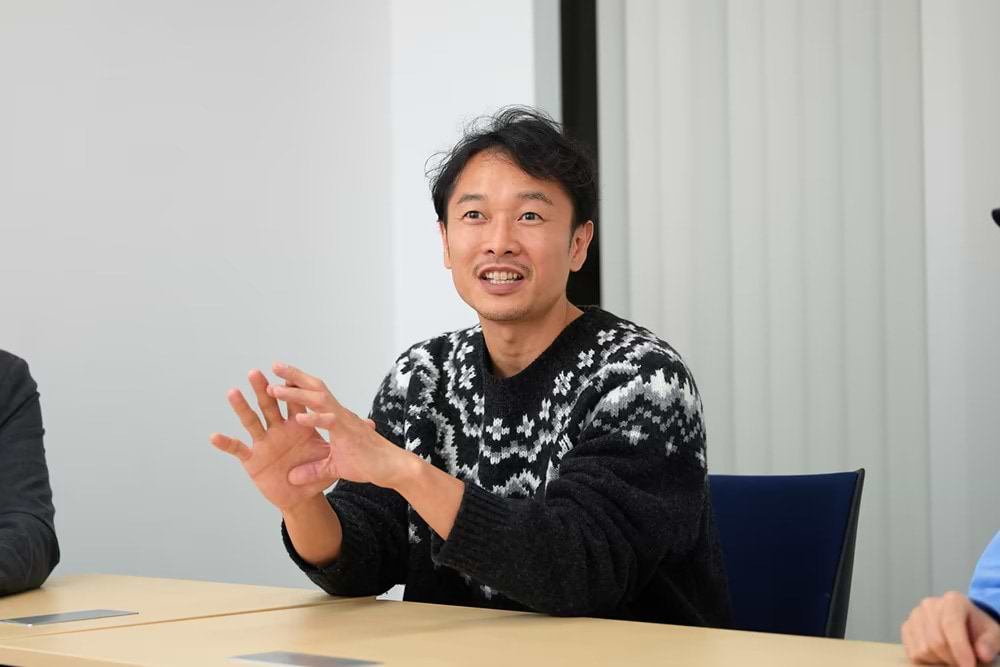
Born in Osaka Prefecture in 1981, Kimura founded STARRYWORKS in 2006 and produces content that combines design and technology in fields such as entertainment, advertising, and product development. In 2015, Kimura set up the subsidiary Yami Inc. specializing in horror content. In 2016, he founded BUTTON Inc., specializing in parent–child communication, before starting Hue Inc., a restaurant business in 2021. He has been a professor at Osaka University of Arts since 2018.
Tsuchiya: It’s an interesting idea. Just like the dress-up feature on various devices, in the not-too-distant future, a marketplace-like system may allow you to download sound assets designed by other designers and install them in your car.
Kimura: I believe interiors and panels will become screens in the future, and that we are heading toward a future in which design themes of high-end fashion brands will be available in the marketplace.
Himeno: However, from the automaker’s perspective, the transition to EVs and the elimination of motor noise make people feel that their car’s “engine” is losing part of its identity. So, when developing EVs, automakers may consider expressing their brand’s new identity through EV driving sounds. In that sense, I see EV sound design as continuing to evolve from the perspective of both users and automakers.
Tomoyasu: I agree. If one asks, What will brand sounds be like?, I see determining that as requiring a lot of testing. VDX Studio will be useful for that kind of testing as well. People don’t experience the sound of a car as a standalone sound but, rather, as part of the sounds and vibrations produced when a car is driven. So, being able to conduct multiple trials at lower cost than testing with an actual car will be important.
Tsuchiya: Personally, I think there is a lot of potential in trying to link the driver’s biometric information—such as heart rate—with a car’s driving sounds. Just as the engine will sound different when your car is not running properly, if you realize that the driving sounds linked to your biometric information suddenly are different, the relationship between people and their cars is sure to change. By treating the car as a single interactive system that includes the driver, a variety of designs will become possible through the medium of sound.
Himeno: Biometric information is already available, including an individual’s heart rate, brainwaves, pupil diameter, and the make up of palm sweat. By assessing sounds using such information and having AI learn from the data, it may be possible to generate a desired sound at any given time. I would even go so far as to suggest that we shall be able to determine whether the driver is concentrating on driving or is distracted.
Kimura: In terms of sensing danger, I believe there is potential in sounds outside the car as well. By using microphones to collect ambient sounds from all sides, it should be possible, even with the car windows closed, to selectively let through external sounds that are important depending on the situation.
For example, if the sounds of cars and bicycles that are out of your rear field of vision could be played from rear speakers inside the car, it would make drivers more aware of what was happening behind them. This could help prevent accidents. Those sounds also might be used to intuitively communicate situations that cars know, as it were, but are difficult for people to detect.
Tsuchiya: Just the ideas we’ve had, I think there is a lot of potential in EV sound design. These kinds of efforts will come to fruition through collaboration among companies, including automakers, auto parts manufacturers, car navigation system manufacturers, and manufacturers of car audio systems. I hope that we also will put to good use our knowledge and expertise, as we help design the driving experience of the future.
Related Link
EV Sound Design: VDX Studio × UNMUTE (Japanese language only)
